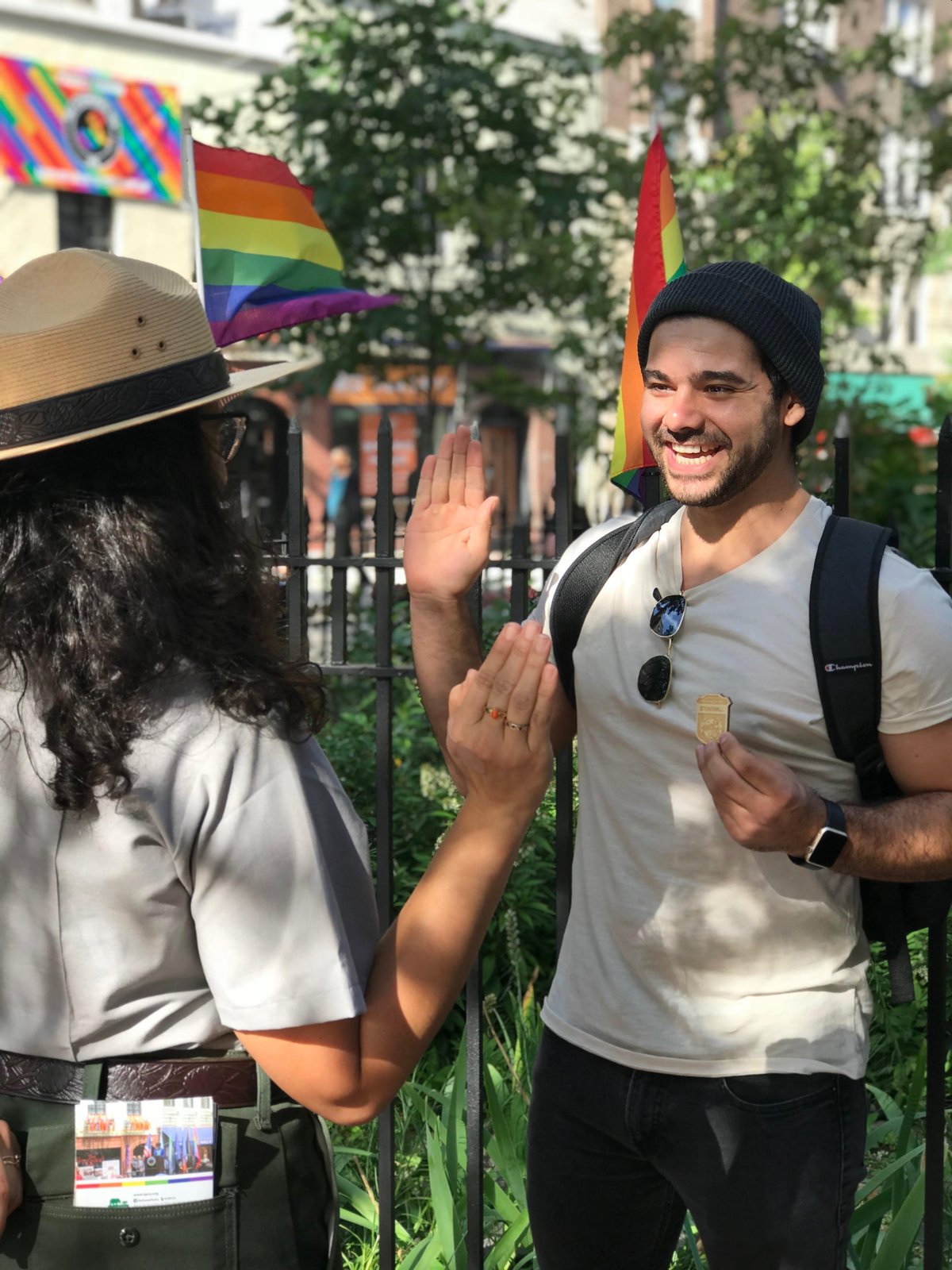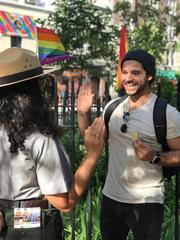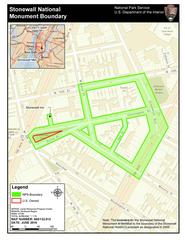
Stonewall National Monument Visiting Hours, Tickets, and New York City Historical Sites Guide
Date: 14/06/2025
Introduction: The Legacy of Stonewall
The Stonewall National Monument, situated in the heart of Greenwich Village, New York City, is a profound emblem of resilience, resistance, and the ongoing pursuit of LGBTQIA+ rights in the United States. The monument commemorates the Stonewall Uprising of June 1969—a watershed moment when a spontaneous series of protests following a police raid at the Stonewall Inn galvanized the modern LGBTQ+ civil rights movement. This pivotal event led to the formation of influential advocacy groups, the first Pride marches, and an ongoing legacy of activism that continues to inspire generations worldwide (PBS; History.com; National Park Service).
Designated as the first U.S. national monument dedicated to LGBTQ+ history in 2016 by President Barack Obama, Stonewall encompasses Christopher Park, the Stonewall Inn, and surrounding streets that played a central role in the uprising (Obama White House Archives). The recently opened Stonewall National Monument Visitor Center offers immersive exhibits, educational programs, and a space for community engagement, ensuring the legacy of Stonewall is preserved and shared with all (AP News; Time Out New York).
This comprehensive guide provides essential information on Stonewall National Monument visiting hours, ticketing, accessibility, guided tours, nearby attractions, travel tips, and answers to frequently asked questions, enabling you to experience this iconic site to its fullest.
Contents
- Introduction and Significance
- The Stonewall Inn and LGBTQ+ Life in 1960s NYC
- The Stonewall Uprising: Timeline and Key Figures
- Aftermath and the Birth of a Movement
- National Monument Designation and Visitor Center
- Visiting Information: Hours, Tickets, Accessibility
- Guided Tours, Events, and Educational Programs
- Nearby Attractions and Travel Tips
- Frequently Asked Questions (FAQ)
- Conclusion
- References
The Stonewall Inn and LGBTQ+ Life in 1960s New York
In the 1960s, LGBTQ+ individuals faced widespread discrimination and criminalization. The Stonewall Inn, located at 51-53 Christopher Street, was one of the few places where marginalized people could gather. Despite its mafia-run management and frequent police raids, it became a haven for a diverse community—including drag queens, trans women, people of color, and unhoused youth—who found acceptance and solidarity within its walls (National Geographic).
The Stonewall Uprising: June 28 – July 3, 1969
The Police Raid and Resistance
On June 28, 1969, a police raid on the Stonewall Inn sparked a historic act of resistance. Instead of dispersing, patrons and bystanders fought back, throwing objects and shouting for “gay power,” forcing police to barricade themselves inside the bar (History.com; PBS).
Multi-Night Protests and Community Impact
The conflict continued for six nights, drawing thousands of LGBTQ+ people and allies to the streets. The uprising provided an unprecedented sense of unity and visibility, and the Stonewall Inn became a focal point of activism (NPCA).
Key Figures
Prominent activists emerged from Stonewall, including Marsha P. Johnson and Sylvia Rivera—trans women of color who became leading voices for LGBTQ+ and transgender rights. Their legacies, along with those of other activists like Dick Leitsch and Craig Rodwell, are now commemorated in educational programs and public art (LGBTQ History; AP News).
Aftermath: The Birth of a Movement
The Stonewall Uprising marked a decisive shift from assimilationist tactics to visible, radical activism. New organizations like the Gay Liberation Front and Gay Activists Alliance formed, championing full equality for all LGBTQ+ people (History.com; LGBTQ History). The first anniversary march in 1970, known as Christopher Street Liberation Day, laid the foundation for annual Pride celebrations worldwide (PBS).
National Monument Designation and the Visitor Center
In 2016, Stonewall became the first national monument dedicated to LGBTQ+ rights (Obama White House Archives). The site includes Christopher Park, the Stonewall Inn, and surrounding streets. On June 28, 2024, the Stonewall National Monument Visitor Center opened at 51 Christopher Street, offering interactive exhibits, archival displays, and educational programming (Time Out New York; AP News).
Visiting the Stonewall National Monument
Location & Getting There
- Address: 38-64 Christopher Street, Greenwich Village, Manhattan, NYC (NPS official site)
- Nearest Subway: 1 train to Christopher Street–Sheridan Square Station; A, C, E, B, D, F, M trains to West 4th Street–Washington Square.
- Bus: M8 and M20 lines.
- Parking: Limited street parking; public transit or rideshare is recommended.
Visiting Hours
- Christopher Park:
- May–October: 7:00 AM – 8:00 PM
- November–April: 7:00 AM – 5:00 PM
(NPS)
- Visitor Center (51 Christopher Street):
- Tuesday–Sunday: 10:00 AM – 4:00 PM; closed Mondays.
- Reservations required during initial months after opening (AFAR).
- Stonewall Inn:
- Daily: 2:00 PM – 11:00 PM (21+ only) (ParkChasers).
Admission and Tickets
- No entrance fees for Christopher Park, the monument, or the Visitor Center (NPS).
- Visitor Center may require free reservations at high-demand times (AFAR).
- No tickets are needed for general entry.
Accessibility
- Christopher Park: Wheelchair-accessible entrance on Fourth Street with brick-paved paths (NPS).
- Visitor Center: Fully accessible; contact NPS in advance for specific accommodations.
- Restrooms: No public restrooms in the park; limited facilities at the Visitor Center (AFAR).
What to See and Do
- Christopher Park:
- View the Gay Liberation statues by George Segal (1992), interpretive signage, and rainbow flags.
- Stonewall Inn:
- Visit the historic LGBTQ+ bar (21+), a living symbol of the movement.
- Visitor Center:
- Interactive exhibits, video panels, music from the era, short documentary screenings, and community events (AFAR).
- National Park Service passport stamp available.
- Self-Guided Tours:
- Walk through historic Greenwich Village using downloadable maps (ParkChasers).
- Ranger Programs:
- Year-round educational talks and guided tours (NPS).
- Virtual Experiences:
- Explore “Stonewall Forever” (Stonewall Forever) for an online storytelling platform.
Best Times to Visit
- June (Pride Month):
- Most vibrant, with events and crowds (Forbes).
- Spring or Fall:
- Pleasant weather and smaller crowds.
- Winter:
- Shorter hours, fewer crowds, but open year-round (The Gate with Brian Cohen).
Nearby Attractions
- Federal Hall National Memorial and Hamilton Grange: Learn about foundational moments in U.S. history.
- Statue of Liberty & Ellis Island: Accessible by ferry.
- NYC LGBT Community Center: A hub for community and resources.
- West Village: Enjoy dining, shopping, and nightlife (ParkChasers).
Visitor Tips
- Arrive early during weekends or June for the best experience.
- Collect the NPS passport stamp and photograph key landmarks.
- Engage with ranger programs and community events.
- Dress for the season—most activities are outdoors.
- Plan for accessibility needs—contact the NPS for accommodations.
- Use public transit due to limited parking.
- Share your visit on social media to help raise awareness of LGBTQ+ history.
Frequently Asked Questions (FAQ)
Q: Are there tickets or entrance fees?
A: No. Admission to the monument, park, and Visitor Center is free; reservations may be needed for the Visitor Center during high-demand periods.
Q: What are the visiting hours?
A: Christopher Park: 7:00 AM–8:00 PM (May–October), 7:00 AM–5:00 PM (November–April). Visitor Center: Tuesday–Sunday, 10:00 AM–4:00 PM, closed Mondays.
Q: Is the site wheelchair accessible?
A: Yes, the park and Visitor Center are accessible.
Q: Where are restrooms?
A: No public restrooms in the park; limited access in the Visitor Center.
Q: Is the Stonewall Inn open to visitors?
A: Yes, for patrons 21 and over.
Q: When is the best time to visit?
A: Spring, fall, or June during Pride Month (expect crowds in June).
Visual and Interactive Resources
- Stonewall Forever virtual tour
- NPS Stonewall site images and maps
- Visitor Center exhibits and video displays
Internal Resources
- Top NYC Historical Sites to Explore
- Guide to LGBTQ+ History in New York City
- Visiting National Parks in Urban Settings
Conclusion
Stonewall National Monument remains a cornerstone of LGBTQ+ history and American civil rights, honoring the bravery of those who fought for equality. Its accessible grounds, immersive exhibits, and educational programming offer a powerful and inclusive experience for all visitors. Plan your visit with this guide, download the Audiala app for audio tours, and explore more NYC historical sites to connect with the enduring spirit of Stonewall.
References
- PBS: Stonewall Milestones—American Gay Rights Movement
- History.com: Stonewall Riots Timeline
- National Geographic: How Stonewall Uprising Ignited Modern LGBTQ Rights Movement
- National Park Service: Stonewall National Monument
- Obama White House Archives: Presidential Proclamation—Stonewall National Monument
- AP News: Stonewall National Monument Visitor Center Opens
- Time Out New York: Inside the Stonewall National Monument Visitor Center
- The Art Newspaper: Mentions of Transgender and Queer Removed from Stonewall Monument Website
- AFAR: The National Park System Opened Its First LGBTQ Center
- ParkChasers: What to See at Stonewall National Monument
- Stonewall Forever virtual tour
- Forbes: New York City Pride’s 2025 Theme
- The Gate with Brian Cohen: Revisiting Stonewall National Monument





























































































































































































































































































